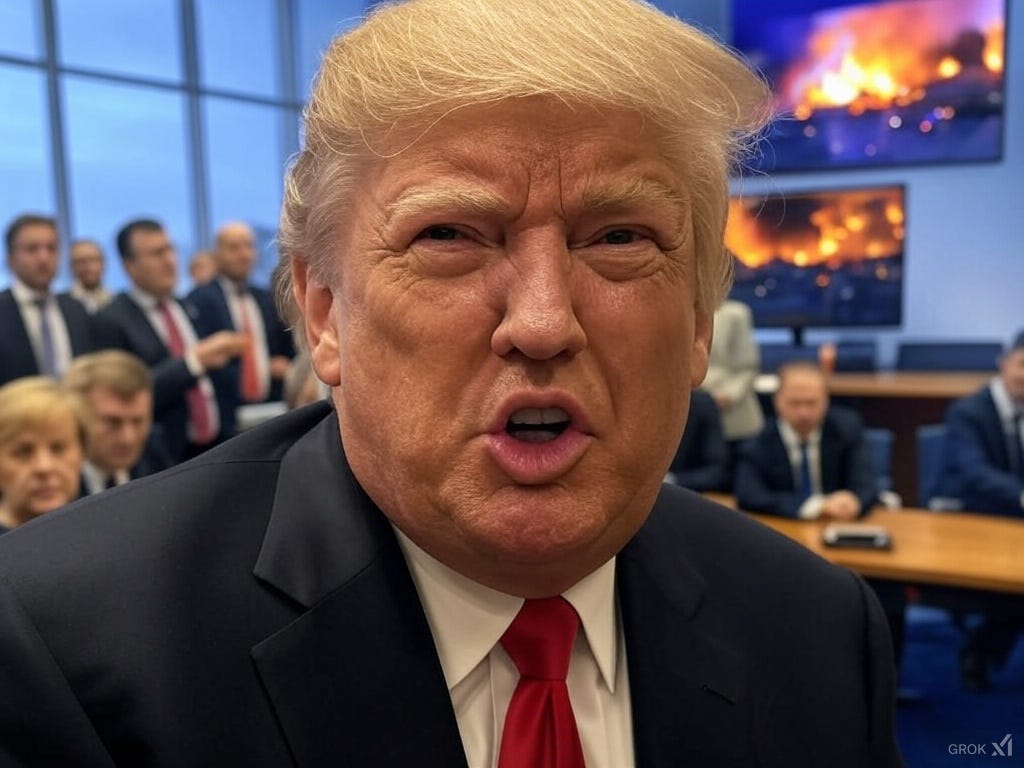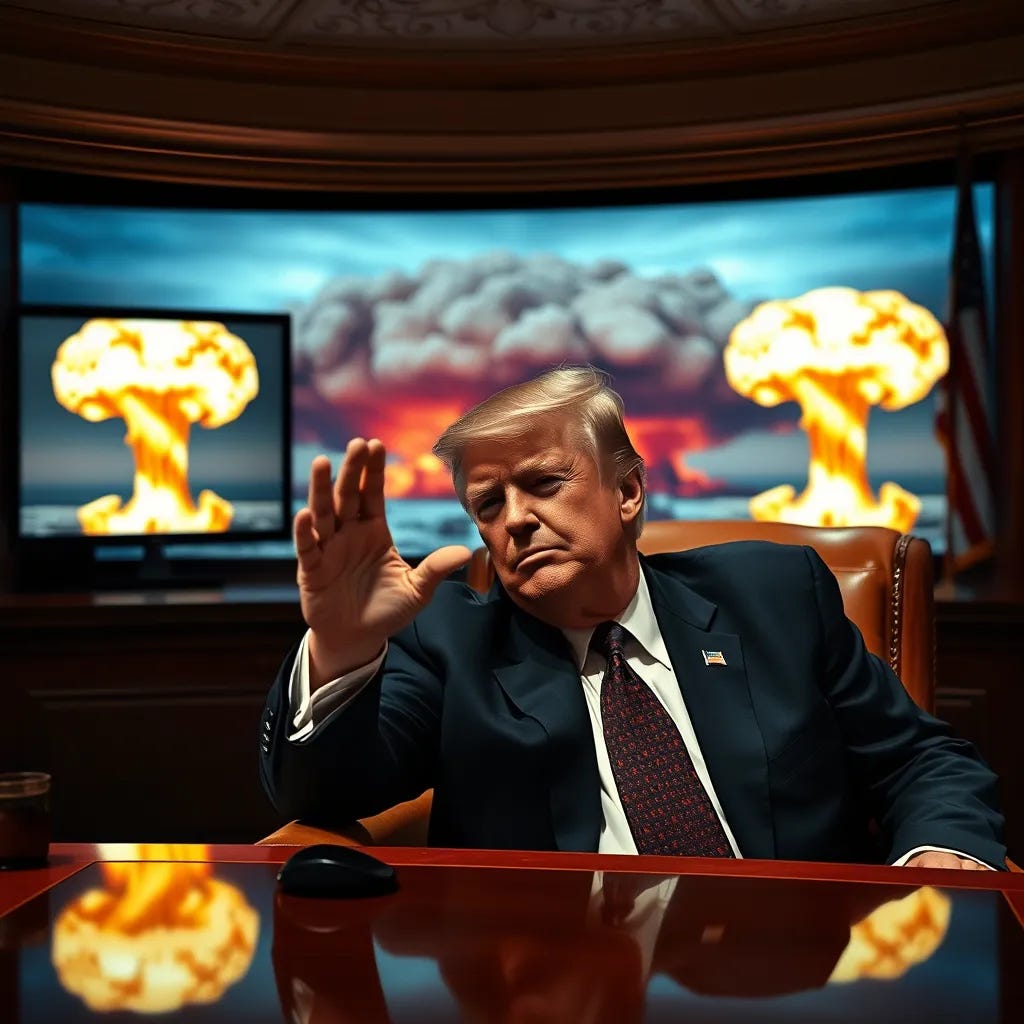In light of recent events in the Trump administration I asked Grok 3 to make four base scenarios, from best to worst case, for the coming years.
Best-Case Scenario: Unity and Prosperity
In this optimistic scenario, Trump defies expectations, pivoting to a unifying agenda. Deportations focus narrowly on violent offenders (200,000 by 2028), paired with a 2026 immigration reform bill—say, a merit-based system with a path to citizenship for 5 million—passed with bipartisan support. Tariffs are symbolic (1% across the board), spurring domestic manufacturing without disrupting trade; inflation stays at 2%, and GDP grows at 3%, cutting unemployment to 3.5%.
Trump leverages his business instincts, pushing a $2 trillion infrastructure and green energy package in 2027, creating millions of jobs and bridging red-blue divides. His executive orders soften—diversity bans are advisory, not mandatory—and courts uphold most, avoiding major unrest. Approval climbs to 55%, bolstered by a booming economy and rare outreach to Democrats on issues like drug pricing, where he caps costs in 2026.
Globally, Trump stays in NATO and the Paris Agreement, reframing them as “America First” wins after allies boost contributions. He negotiates a landmark China trade deal in 2027, reducing the deficit and securing tech supremacy. Russia backs off Ukraine under economic pressure. By 2028, Trump leaves office a hero to his base and a grudging success to critics, having presided over a rare period of growth and relative harmony.
Good-Case Scenario: Pragmatic Wins with Tradeoffs
In this scenario, Trump tempers his ambitions with pragmatism, achieving modest successes while navigating constraints. Deportations target criminals (around 500,000 by 2027), winning applause from his base without overwhelming the system. Tariffs start at 5% but are dialed back to 2% after negotiations with Canada and the EU, keeping inflation below 3% and GDP growth at 2.5%. A bipartisan infrastructure bill passes in 2026—$1 trillion for roads and bridges—boosting jobs (unemployment dips to 3.8%) and rural economies, though it swells the deficit.
Domestically, Trump’s executive orders face pushback; courts strike down the gender redefinition but uphold limits on diversity programs, balancing his base’s demands with legal limits. Protests occur—say, 50,000 march in D.C. in 2026—but violence is minimal. Congress, wary of overreach, checks his power, rejecting plans to dismantle the NLRB or FTC. Public approval steadies at 45%, buoyed by economic gains but tempered by ongoing culture wars.
Internationally, Trump pressures NATO allies to spend more (they hit 2% GDP by 2027), strengthening the alliance without leaving it. He brokers a shaky Ukraine-Russia ceasefire in 2026, claiming credit despite limited enforcement. China tensions simmer, but trade deals avoid escalation. By 2028, the U.S. emerges stronger economically, though social cohesion remains fragile, and Trump retires as a polarizing but effective dealmaker.
Bad-Case Scenario: Stagnation and Polarization
Here, Trump’s administration achieves some goals but at significant cost, resulting in stagnation rather than collapse. Mass deportations begin in 2025 but scale back after legal and logistical hurdles—say, deporting 1 million instead of the promised 11 million. Tariffs are implemented at a reduced 5%, raising consumer prices (inflation hits 3.5% in 2026) but avoiding a full trade war. Growth slows to 1.5% annually, and unemployment creeps up to 4.7%, hitting rural Trump strongholds hardest.
Politically, Trump’s executive orders—like banning diversity programs and redefining gender—spark lawsuits and protests but survive court challenges, entrenching cultural divides. Red states embrace his policies, while blue states like California resist, filing over 100 lawsuits by 2027. Congress passes a partial extension of the 2017 tax cuts, bloating the deficit further, but blocks more radical moves like gutting environmental regulations. Public approval hovers around 40%, with frequent scandals—like conflicts of interest at Trump properties—fueling outrage but not impeachment.
Globally, Trump pulls out of the Paris Agreement again in 2025, alienating allies, though NATO holds together after tense negotiations. Russia and China test U.S. resolve—think cyberattacks or South China Sea skirmishes—but avoid direct conflict. By 2028, the U.S. is stable but stagnant, with a frayed social fabric and a government gridlocked by partisan rancor. Trump exits office exhausted, leaving a legacy of division.
Worst-Case Scenario: Authoritarian Drift and Economic Collapse
In this scenario, Trump’s second term spirals into a sustained erosion of democratic norms and economic stability. Over the next few years, his administration pushes aggressive policies like mass deportations and universal tariffs (10% on all imports, 60% on Chinese goods), which spark immediate backlash. Deportation efforts falter as targeted countries refuse to accept millions of returnees, leading to overcrowded detention facilities and reports of human rights abuses. Meanwhile, tariffs trigger retaliatory measures from trading partners, igniting a global trade war. Inflation surges past 5% by 2026, driven by higher costs for goods, while GDP growth stalls below 1%, teetering on recession.
Domestically, Trump doubles down on loyalty, replacing career civil servants with political appointees across agencies like the DOJ and EPA. His pardons of January 6 rioters embolden extremist groups, who stage violent protests against perceived enemies—think armed clashes in cities like Portland or Atlanta by mid-2026. Congress, despite a slim Republican majority, fractures over his agenda; moderates balk at proposals like dismantling the Affordable Care Act without a replacement. By 2027, judicial challenges pile up, but a conservative Supreme Court upholds key executive actions, deepening public distrust in institutions.
Internationally, Trump withdraws from NATO in 2026, citing cost burdens, leaving Eastern Europe vulnerable as Russia annexes parts of Ukraine unchallenged. China exploits the chaos, expanding influence in Asia. By 2028, the U.S. faces record unemployment (near 7%), a ballooning deficit from tax cuts, and a polarized society where half the population views the government as illegitimate. Trump’s health declines at 82, and succession debates intensify, with no clear resolution as his term ends.
… and then asking for even worse worst-case scenario:
Even Worse Worst-Case Scenario: Collapse of Order and Global Isolation
In this nightmare scenario, Trump’s administration begins with an immediate overreach that unravels the nation. By mid-2025, he orders a militarized mass deportation campaign targeting 15 million undocumented immigrants, deploying the National Guard and private contractors. Resistance erupts— sanctuary cities like Los Angeles and Chicago defy federal mandates, leading to armed standoffs. By 2026, botched operations result in documented atrocities—think mass casualties during raids in Texas border towns—and leaked footage sparks nationwide riots. Over 100,000 protesters clash with police in cities like New York and Miami, with death tolls in the dozens.
Economically, Trump imposes a 20% tariff on all imports and 80% on China in early 2026, triggering a catastrophic trade war. China dumps U.S. Treasury bonds, crashing the dollar’s value; inflation soars to 10% by 2027, and gas prices hit $8 a gallon. The stock market plummets—Dow Jones falls below 20,000—wiping out retirement savings. Supply chains collapse, leaving grocery shelves bare; food riots break out in suburban Ohio and rural Georgia, with militias seizing local control. GDP contracts by 5% annually, and unemployment spikes to 12%, rivaling Great Depression levels.
Politically, Trump declares a national emergency in 2026, citing “domestic enemies,” and suspends habeas corpus, detaining thousands—journalists, activists, even moderate Republicans—in makeshift camps. Congress, paralyzed by a razor-thin GOP majority, fails to override his vetoes as he guts Medicare, Social Security, and environmental laws via executive fiat. The Supreme Court, packed with loyalists after a rushed 2025 appointment, rubber-stamps his actions. By 2027, half the states—led by California and Texas—threaten secession, forming rival blocs with their own militias and tax systems. Political assassinations spike, targeting governors and senators on both sides.
Internationally, Trump exits NATO and the UN in 2026, leaving allies stunned as Russia invades Poland and China seizes Taiwan unchallenged. The U.S. military, overstretched by domestic unrest, can’t respond; bases abroad close as funding dries up. A 2027 cyberattack—attributed to Iran—shuts down the U.S. power grid for weeks, killing thousands in winter blackouts. Global trade routes shift away from America, isolating it economically; the dollar loses reserve currency status to the yuan.
By 2028, Trump, now 82 and visibly frail, clings to power amid rumors of a stroke, with succession battles erupting between family members and cabinet hardliners like Stephen Miller. Civil war looms as armed factions—left-wing communes, right-wing militias, and rogue military units—control swaths of territory. The U.S. population drops by millions from emigration, starvation, and violence; life expectancy falls below 70. As his term ends, Trump declares martial law, but the government collapses into irrelevance, leaving a fractured nation and a world order dominated by rival powers.
… but could it get even worse, oh yes!
Even More Worse Worst-Case Scenario: Tyranny, Plague, and Armageddon
The nightmare begins in 2025 with Trump’s inauguration, where he vows to “cleanse America” and signs an executive order dissolving Congress, claiming “national security” after a staged attack—say, a truck bombing in D.C. blamed on immigrants. The military, loyal to his appointees, enforces a coup; dissenters like Schumer and McConnell are arrested, and the Constitution is suspended. By 2026, Trump crowns himself “President for Life,” backed by a cult-like following and a propaganda machine that shuts down all independent media—CNN, X, even local papers—replacing them with state-run broadcasts.
Deportations escalate into ethnic purges, targeting not just undocumented immigrants but anyone deemed “un-American”—think 20 million rounded up, with millions dying in squalid camps from starvation and disease. Resistance turns apocalyptic: urban guerrilla warfare erupts, with Antifa and MAGA militias alike detonating car bombs and seizing city halls. By 2027, chemical weapons—stolen from military stockpiles—are unleashed in Chicago and Houston, killing tens of thousands. The death toll from domestic conflict surpasses 1 million, and entire states like Oregon and Alabama become lawless wastelands ruled by warlords.
Economically, Trump bans all foreign trade in 2026, collapsing the dollar overnight. Hyperinflation hits—bread costs $50, gas $100 a gallon—and the banking system fails, rendering savings worthless. A desperate “America First” energy push drills every national park, but a 2027 oil rig explosion in the Gulf of Mexico triggers an ecological disaster: a 500,000-square-mile dead zone poisons fisheries, sparking mass famine along the coast. Climate denial accelerates warming; by 2028, Category 6 hurricanes flood Florida and Texas yearly, displacing 10 million, while wildfires consume California, leaving its 40 million residents without water or power.
A biological horror emerges in 2027: a weaponized pathogen—leaked from a deregulated U.S. lab—spreads uncontrollably, with a 70% fatality rate. Quarantines fail as Trump refuses international aid, calling it a “hoax”; 50 million Americans die by 2028, and the population drops below 200 million. Cities like New York and L.A. are abandoned, overrun by rats and plague victims, while rural survivors turn to cannibalism amid food shortages.
Globally, Trump launches preemptive nuclear strikes on China and Russia in 2027 after they mock his regime, miscalculating their response. Retaliation levels D.C., New York, Los Angeles, and Houston; 30 million die instantly, and fallout poisons the Midwest breadbasket. NATO dissolves, and a Sino-Russian alliance dominates, invading weakened Europe and Asia unopposed. The U.S., radioactive and isolated, faces a second strike in 2028 as Iran and North Korea join the fray, targeting surviving cities like Atlanta and Seattle.
By Trump’s term end, he’s a delusional figurehead in a Mar-a-Lago bunker, dying of untreated illness at 82 as aides flee. The U.S. fractures into irradiated fiefdoms—population under 100 million, life expectancy below 50—amid nuclear winter that kills crops and triggers global famine. Civilization unravels; billions perish worldwide, and humanity teeters on extinction, with America a smoldering ruin blamed for the endgame.
Good luck to us all!








